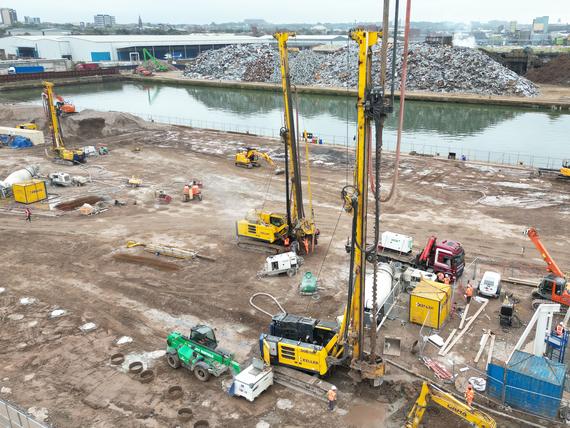Peel Ports Group invested £28 million on a new facility at the Port of Liverpool. The new facility, referred to as Alexandra Dock Multi-User Warehouse (MUW), will be able to store a variety of commodities and will also have 300 metres of dedicated quayside and state-of-the-art cranes to optimise vessel discharge.

The project
The construction of a 240,000sq ft warehouse on a brownfield reclaimed docklands site. The warehouse is the length of five football pitches (400m) and will be used for the handling and storage of cargo at the port.
The challenge
To provide a foundation solution through up to 15.0m of very low strength made ground and low to moderate strength clays while minimising vibration and load shed onto the nearby dock wall. The specified requirement for a very high slab loading of 100kN/m2 coupled with the presence of sandstone bedrock at the toe of the columns, generated high bending moment forces which warranted further consideration. Our remit was to avoid a fully piled and suspended solution for the whole structure which would have impacted the project cost and timescales and generated significant quantities of contaminated spoil and carbon.
The solution
For the frame and crane base areas, which were subject to high axial, lateral and tensile loadings, a CFA piled solution was proposed. Keller installed around 1800 350mm diameter CFA piles down to the sandstone bedrock strata at 15-19m depth. All piles were cage reinforced and the crane base piles included a 900mm diameter flared head. The flared head reduced the span between each pile and enabled a more efficient sub-structure design.
For the floor slab areas, around 5000 300mm diameter Rigid inclusions were constructed to lengths of up to 15.0m with the columns just toeing into the sandstone bedrock strata.
For the areas close to the dock wall, a no vibration auger replacement (AR) method was used, and a suspended slab was adopted to avoid any load shed onto the dock wall. Each AR column was topped off with a 900mm diameter enlarged head which served to reduce the shear forces as well as the spanning distance between the columns. This approach enabled the slab designer to reduce the thickness of the suspended slab.
For the remaining slab areas, a low vibration auger displacement (AD) method was adopted to avoid spoil. Due to the very high slab loadings required and the presence of very low strength strata just below the platform, a more innovative design was called for which would facilitate the adoption of a ground bearing slab. The combination of high loadings, very weak strata, and a sandstone toe was generating significant bending moment forces which needed to be reduced. Keller proposed the installation of a 750mm diameter bulb and this was formed just below the 450mm thick load distribution layer. The formation of the plug substantially reduced the bending moment so we could offer a ground bearing slab.
The installation works were successfully completed in challenging ground conditions. We were able to hand over areas of the site while we continued with our works, to allow the main contractor to progress swiftly with the foundations.
